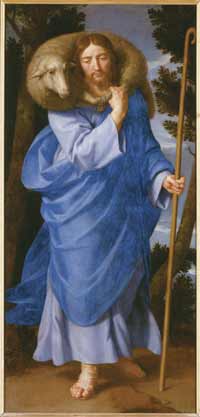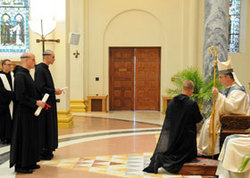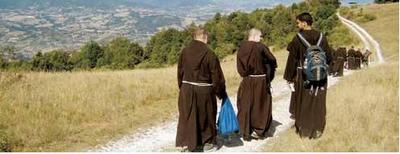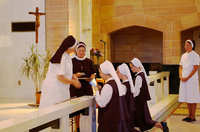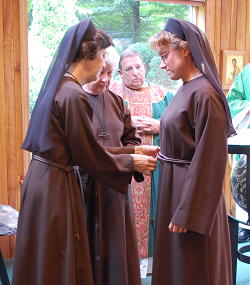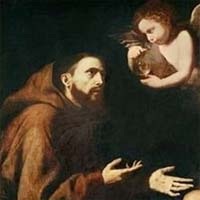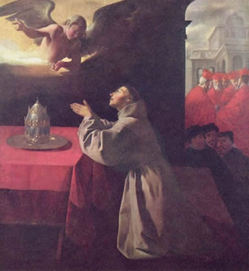 Pope Benedict XVI named today João Bráz de Aviz, 63, Archbishop of Brasilia, as the new Prefect of the Congregation for Institutes of Consecrated Life and Societies of Apostolic Life (AKA Congregation of Relgious), replacing Franc Cardinal Rode, CM.
Pope Benedict XVI named today João Bráz de Aviz, 63, Archbishop of Brasilia, as the new Prefect of the Congregation for Institutes of Consecrated Life and Societies of Apostolic Life (AKA Congregation of Relgious), replacing Franc Cardinal Rode, CM.
Tag: religious life
Religious life 2010: Profession of vows, entrances and ordinations
- a common prayer life and personal prayer which includes Mass, the Divine Office, Adoration of the Blessed Sacrament, Lectio Divina, the rosary; a daily hour could be optional but there ought to be a good reason why a religious is not making a holy hour more often than not;
- a common vision for living and serving the gospel in the Catholic Church as it is today, not as the Church “was in the 1970s, 1980s, 1990s” or what the Church “should be”; the work done together, whether serving the poor, teaching school, being chaplains needs to cohere to the founding charism, be done together, and with joy in the Risen Lord; serving the gospel and the Church means being faithful to the Church’s teaching authority, which means pastoral authority of the Pope and the bishops;
- a caring fraternal life
- the wearing of a religious habit not only in the house but in public; if you won’t wear the habit in a restaurant or movie theater or any other place, including the airport, then you shouldn’t be there; the wearing of the roman collar for religious orders should be done by exception if there is a legitimate habit available and the lapel pin just doesn’t cut it.
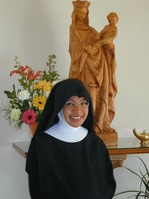
World Day of Vocations 2010
In his 2010 message for World Day of Vocations, celebrated
today on Good Shepherd Sunday, Pope Benedict names three elements for someone
willing to follow a call to priesthood and/or religious life: friendship with
Jesus, total self-gift to God and a life of communion with all people. All of this situated in the sacrifice of Christ on the Cross and our relationship to that very cross. Read the
three essential paragraphs from the Pope’s message below.
A fundamental
element, one which can be seen in every vocation to the priesthood and the
consecrated life, is friendship with Christ. Jesus lived in constant union with
the Father and this is what made the disciples eager to have the same
experience; from him they learned to live in communion and unceasing dialogue
with God. If the priest is a “man of God”, one who belongs to God and helps others
to know and love him, he cannot fail to cultivate a deep intimacy with God,
abiding in his love and making space to hear his Word. Prayer is the first form
of witness which awakens vocations. Like the Apostle Andrew, who tells his
brother that he has come to know the Master, so too anyone who wants to be a
disciple and witness of Christ must have “seen” him personally, come to know
him, and learned to love him and to abide with him.
Another aspect of the
consecration belonging to the priesthood and the religious life is the complete
gift of oneself to God. The Apostle John writes: “By this we know love, that he
laid down his life for us; and therefore we ought to lay down our lives for the
brethren” (1 Jn 3:16). With these words, he invites the disciples to enter into
the very mind of Jesus who in his entire life did the will of the Father, even
to the ultimate gift of himself on the Cross. Here, the mercy of God is shown
in all its
fullness; a merciful love that has overcome the darkness of evil,
sin and death. The figure of Jesus who at the Last Supper, rises from the
table, lays aside his garments, takes a towel, girds himself with it and stoops
to wash the feet of the Apostles, expresses the sense of service and gift
manifested in his entire existence, in obedience to the will of the Father (cf.
Jn 13:3-15). In following Jesus, everyone called to a life of special
consecration must do his utmost to testify that he has given himself completely
to God. This is the source of his ability to give himself in turn to those whom
Providence entrusts to him in his pastoral ministry with complete, constant and
faithful devotion, and with the joy of becoming a companion on the journey to
so many brothers and sisters, enabling them too to become open to meeting Christ,
so that his Word may become a light to their footsteps. The story of every
vocation is almost always intertwined with the testimony of a priest who
joyfully lives the gift of himself to his brothers and sisters for the sake of
the Kingdom of God. This is because the presence and words of a priest have the
ability to raise questions and to lead even to definitive decisions (cf. John
Paul II, Post-Synodal Apostolic Exhortation Pastores Dabo
Vobis, 39).
A third aspect which necessarily characterizes the
priest and the consecrated person is a life of communion. Jesus showed that the
mark of those who wish to be his disciples is profound communion in love: “By
this all men will know that you are my disciples, if you have love for one
another” (Jn 13:35). In a particular way the priest must be a man of communion,
open to all, capable of gathering into one the pilgrim flock which the goodness
of the Lord has entrusted to him, helping to overcome divisions, to heal rifts,
to settle conflicts and misunderstandings, and to forgive offences. In July 2005,
speaking to the clergy of Aosta, I noted that if young people see
priests who appear distant and sad, they will hardly feel encouraged to follow
their example. They will remain hesitant if they are led to think that this is
the life of a priest. Instead, they need to see the example of a communion of
life which can reveal to them the beauty of being a priest. Only then will a
young man say, “Yes, this could be my future; I can live like this” (Insegnamenti
I, [2005], 354). The Second
Vatican Council, in speaking of the witness that awakens vocations,
emphasizes the example of charity and of fraternal cooperation which priests
must offer (cf. Decree Optatam
Totius, 2).
The Mendicant witness of Christ and the Church is urgent & irresistible
The renewal of religious life is also one of Pope Benedict’s priorities. AND boy does it need it. The general state of religious life in this country at least, is circling the drain. Religious life’s sad state is not merely about gaining new recruits, or wearing habits or working with the marginalized, but being faithful to Christ and the Church today, not some fantasy of what one “guru” hopes the Church to be. There are notable exceptions to this evaluation, but even those orders getting vocations there are concerns with the institutional rot in the ranks, and therefore they are fragile. Benedict’s general audience address yesterday shows us the breadth and depth of the work needed to be done AND the desire to see the mendicant life thrive and contribute to the upbuilding of the Kingdom. Being faithful to the charism of the order and to the Magisterium of the Church are essential components to any hope of renewal. The Pope said:
At the beginning of the new year, we look at the history of Christianity, to see how a history develops and how it can be renewed. In it we can see that it is the saints, guided by the light of God, who are the genuine reformers of the life of the Church and of society. Teachers by their word and witnesses with their example, they know how to promote a stable and profound ecclesial renewal, because they themselves are profoundly renewed, they are in contact with the true novelty: the presence of God in the world.
Such a consoling reality — that in every generation saints are born and bear the creativity of renewal — constantly accompanies the history of the Church in the midst of the sorrows and the negative aspects of her journey. We also see come forth, century by century, the forces of reform and of renewal, because the novelty of God is inexorable and always gives new strength to go forward.
This was what happened in the 13th century, with the birth and the extraordinary development of the Mendicant Orders: a model of great renewal in a new historic period. They were called thus because of their characteristic of “begging,” namely, of going to the people humbly for economic support to live the vow of poverty and to carry out their evangelizing mission. Of the Mendicant Orders that arose in that period, the most notable and most important are the Friars Minor and the Preaching Friars, known as Franciscans and Dominicans. They have these names because of their founders, Francis of Assisi and Dominic de Guzmán, respectively. These two great saints had the capacity to wisely read “the signs of the times,” intuiting the challenges that the Church of their time had to face.
A first challenge was represented by the spread of several groups and movements of faithful that, although inspired in a legitimate desire for authentic Christian life, often placed themselves outside of ecclesial communion. They were in profound opposition to the rich and beautiful Church that developed precisely with the flourishing of monasticism. In recent catecheses I reflected on the monastic community of
This brought about the so-called pauper movements of the Medieval Age. They harshly contested the lifestyles of priests and monks of the time, accused of having betrayed the Gospel and of not practicing poverty as the first Christians, and these movements counterpoised to the ministry of the bishops their own “parallel hierarchy.” Moreover, to justify their choices, they spread doctrines that were incompatible with the Catholic faith. For example, the movement of the Cathars or Albigensians proposed again old heresies, such as depreciation and contempt of the material world — opposition to wealth quickly became opposition to material reality as such — the negation of free will, and then dualism, the existence of a second principle of evil equated with God. These movements had success, especially in
With an altogether original choice in the history of consecrated life, the members of these orders not only gave up possession of personal goods, as monks had since antiquity, but even wanted real estate and goods put in the name of the community. In this way they intended to give witness of an extremely sober life, to be in solidarity with the poor and trust only in
And fruits were not lacking: The poor groups that had separated from the Church returned to ecclesial communion or, gradually, were re-dimensioned until they disappeared. Also today, though living in a society in which “having” often prevails over “being,” there is great sensitivity to examples of poverty and solidarity, which believers give with courageous choices. Also today, similar initiatives are not lacking: movements, which really begin from the novelty of the Gospel and live it radically today, putting themselves in God’s hands, to serve their neighbor. The world, as Paul VI recalled in Evangelii Nuntiandi, willingly listens to teachers when they are also witnesses. This is a lesson that must never be forgotten in the endeavor of spreading the Gospel: to live first of all what is proclaimed, to be a mirror of divine charity.
Franciscans and Dominicans were witnesses, but also teachers. In fact, another widespread need in their time was that of religious instruction. Not a few lay faithful, who lived in greatly expanding cities, wished to practice a spiritually intense Christian life. Hence they sought to deepen their knowledge of the faith and to be guided in the arduous but exciting path of holiness. Happily, the Mendicant Orders were also able to meet this need: the proclamation of the Gospel in simplicity and in its depth and greatness was one objective, perhaps the main objective of this movement. In fact, with great zeal they dedicated themselves to preaching. The faithful were very numerous, often real and veritable crowds, which gathered to hear the preachers in the churches and in places outdoors — let us think of St. Anthony, for example. They dealt with themes close to the life of the people, especially the practice of the theological and moral virtues, with concrete examples, easily understood. Moreover, they taught ways to nourish the life of prayer and piety. For example, the Franciscans greatly spread devotion to the humanity of Christ, with the commitment of imitating the Lord. Hence it is not surprising that the faithful were numerous, women and men, who chose to be supported in their Christian journey by the Franciscan and Dominican friars, sought after and appreciated spiritual directors and confessors.
Thus were born associations of lay faithful that were inspired by the spirituality of Sts. Francis and Dominic, adapted to their state of life. It was the Third Order, whether Franciscan or Dominican. In other words, the proposal of a “lay sanctity” won many people. As the Second Vatican Council recalled, the call to holiness is not reserved to some, but is universal (cf. Lumen Gentium, 40). In every state of life, according to the needs of each, there is the possibility of living the Gospel. Also today every Christian must tend to the “lofty measure of Christian life,” no matter what state of life he belongs to!
The importance of the Mendicant Orders grew so much in the Middle Ages that lay institutions, such as labor organizations, ancient corporations and even civil authorities, often took recourse to the spiritual consultation of members of such orders for the writing of their regulations and, at times, for the solution of internal and external opposition. The Franciscans and Dominicans became the spiritual leaders of the Medieval city. With great intuition, they put into practice a pastoral strategy adapted to the transformation of society. Because many people were moving from the countryside to the cities, they placed their monasteries no longer in rural but in urban areas. Moreover, to carry out their activity for the benefit of souls, it was necessary to move in keeping with pastoral needs.
With another altogether innovative choice, the Mendicant Orders abandoned the principle of stability, a classic of ancient monasticism, to choose another way. Friars and Preachers traveled from one place to another, with missionary zeal. As a consequence, they gave themselves an organization that was different from that of the majority of monastic orders. In place of the traditional autonomy that every monastery enjoyed, they gave greater importance to the order as such and to the superior-general, as well as to the structure of the provinces. Thus the mendicants were in general available for the needs of the universal Church. This flexibility made it possible to send friars more adapted to specific missions and the Mendicant Orders reached
Another great challenge was represented by the cultural transformations taking place at that time. New questions made for lively discussions in the universities, which arose at the end of the 12th century. Friars and Preachers did not hesitate to assume this commitment as well and, as students and professors, they entered the most famous universities of the time, founded centers of study, produced texts of great value, gave life to true and proper schools of thought, were protagonists of scholastic theology in its greatest period, and significantly influenced the development of thought.
The greatest thinkers, Sts. Thomas Aquinas and Bonaventure, were mendicants, operating in fact with this dynamism of the new evangelization, which also renewed the courage of thought, of dialogue between reason and faith. Today also there is a “charity of and in truth,” an “intellectual charity” to exercise, to enlighten intelligences and combine faith with culture. The widespread commitment of the Franciscans and Dominicans in the Medieval universities is an invitation, dear faithful, to make oneself present in places of the elaboration of learning, to propose, with respect and conviction, the light of the Gospel on the fundamental questions that concern man, his dignity, and his eternal destiny. Thinking of the role of the Franciscans and Dominicans in the Middle Ages, of the spiritual renewal they aroused, of the breath of new life that they communicated in the world, a monk says: “At that time the world was growing old. Two orders arose in the Church, from which it renewed its youth, like that of an eagle” (Burchard d’Ursperg, Chronicon).
Dear brothers and sisters, let us indeed invoke at the beginning of this year the Holy Spirit, eternal youth of the Church: May he make each one of us feel the urgency of giving a consistent and courageous witness of the Gospel, so that saints will never be lacking, who make the Church shine as a Bride always pure and beautiful, without stain and without wrinkle, able to attract the world irresistibly to Christ, to his salvation.
New Haven natives preparing for priesthood
 Over the years New Haven area Catholics have nurtured the vocations of many men to the priesthood or religious life. In the coming days I am hoping to write more about those who have said “yes” to the Lord in His call to religious life and priesthood. But for the moment let me note here those from the New Haven area that are studying for a religious order or a diocese:
Over the years New Haven area Catholics have nurtured the vocations of many men to the priesthood or religious life. In the coming days I am hoping to write more about those who have said “yes” to the Lord in His call to religious life and priesthood. But for the moment let me note here those from the New Haven area that are studying for a religious order or a diocese:
U.S. women religious to have Vatican visitation
The Vatican announced today that it is initiating the first-ever visitation of women’s religious communities in the United States. The visitations are being undertaken to help strengthen religious communities in the U.S., which are suffering from a sharp drop in vocations and gentrification of their ranks.
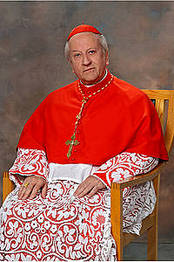 On the heels of issuing a report on the health of U.S. seminaries–which were found to be in relatively good condition–the Vatican’s Congregation for Institutes of Consecrated Life and Societies of Apostolic Life, headed by Cardinal Franc Rodé, is embarking on a comprehensive study of the more than 400 congregations present in the United States. The visitations will only assess those religious who engage in apostolic or active work, and will not involve contemplative communities.
On the heels of issuing a report on the health of U.S. seminaries–which were found to be in relatively good condition–the Vatican’s Congregation for Institutes of Consecrated Life and Societies of Apostolic Life, headed by Cardinal Franc Rodé, is embarking on a comprehensive study of the more than 400 congregations present in the United States. The visitations will only assess those religious who engage in apostolic or active work, and will not involve contemplative communities.
The visitation process is being spearheaded by Connecticut native Mother Mary Clare Millea, A.S.C.J., who was appointed by Cardinal Rodé. Mother Clare is the superior general of the Apostles of the Sacred Heart of Jesus, a group of sisters that is based in Rome but has 135 sisters in the U.S.
According to a December 22, 2008 Vatican decree authorizing the visitations, the study is being undertaken “to look into the quality of the life” of the members of U.S. religious institutes.
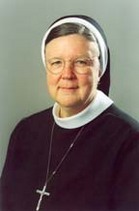 Mother Clare estimates that the project will take about two years to finish, and says that upon completion she will submit a confidential report to Cardinal Rodé. There are no plans to publish the findings.
Mother Clare estimates that the project will take about two years to finish, and says that upon completion she will submit a confidential report to Cardinal Rodé. There are no plans to publish the findings.
Sr. Eva-Maria Ackerman, a member of the Sisters of St. Francis of the Martyr St. George, explained how the several-stage process will work at a press conference in Washington D.C. on Friday.
“First, Mother Clare will solicit voluntary input from the superiors general through inviting them to make personal contacts with her in Rome or in the United States. During the second stage, the major superiors in the United States will be asked for information such as statistics, activities and community practices.”
She continued, “selected on-site visits will be made during the third stage. During this time, the sisters will have an opportunity to share with the visitation teams their joys and hopes, challenges and concerns about their lives as women religious in the Church today. The final stage will be the compilation and delivery of a comprehensive and confidential review by Mother Clare to Cardinal Rodé.
Sr. Ackerman also added that the “visitations are beginning as we speak.”
In a press release announcing the initiative, Mother Millea indicated that while she is not obliged to visit every community of women religious, she looks forward to learning and better understanding the “multi-faceted dimensions of the sisters’ religious lives, as well as their abundant contributions to the Church and society.”
“I am truly humbled, and a bit overwhelmed,” Mother Millea said of her assignment. “While I have visited each of the communities and missions in my own congregation, the thought of gathering facts and findings about nearly 400 institutes across the United States can be daunting in scope.”
“I am praying for all the sisters who will be a part of this Visitation, and hoping for their prayers “both for the good of the process as well as for me in this role,” she added. “I ask the prayers of the American Catholic clergy and faithful too.”
More information about the visits can be found at www.apostolicvisitation.org
